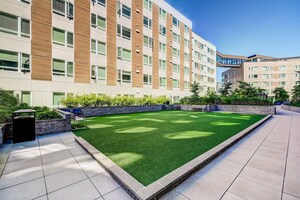LAS VEGAS, May 22, 2017 /PRNewswire/ -- Today JLL launched its inaugural City Retail[i] report at ICSC RECon in Las Vegas, which reveals the 10 most affordable and desirable retail corridors in the United States based on average asking rent per square foot. These shopping districts have growing populations of working millennials, rising foodie scenes, and trendy mixes of up-and-coming retailers and well-known brands. These factors combine to create affordability and stability - the ideal scenario for retailers and investors that want to expand.
"In retail, store location is everything – pick the wrong corner and your brilliant concept can fail," said Naveen Jaggi, President of Retail Brokerage and Capital Markets, JLL. "We know that sometimes retailers want that prime main-and-main location, but just don't have the budget. So, we looked at core U.S. cities to find more affordable areas for retailer expansion."
The Top 10 Most Affordable Prime Urban Retail Corridors:
According to JLL, prime rents in these 10 corridors are the most affordable on a per-square-foot basis:
- Market East, Philadelphia: Once home to vacant lots and failed fortress malls, Market East now attracts large-format retailers looking to tap into the swelling millennial and empty-nester population. Market East's average asking prime retail rent is $50 p.s.f., with annual rent growth of 25 percent.
- Wicker Park, Chicago: This edgy, off-the-beaten path foodie destination is seeing an uptick in residential development, piquing international investor and retailer interest. Wicker Park's average asking prime retail rent is $55 p.s.f., with annual rent growth of 4.5 percent.
- Pike Street, Seattle: Filled with a stable collection of apparel and restaurants, Pike Street serves Seattle's CBD and is expanding east toward Capitol Hill with new restaurants. Pike Street's average asking prime retail rent is $65 p.s.f., with annual rent growth of 18.2 percent.
- Fulton Market, Chicago: Once a hub for industrial and meat distribution, Fulton Market in the West Loop submarket is known for its killer restaurant scene, but is now garnering attention from apparel retailers and investors as it becomes a growth market for corporate headquarters. Average asking prime retail rent is $75 p.s.f., with annual rent growth of 8.9 percent.
- The Marina, San Francisco: This corridor has seen a spike of athleisure and boutique fitness studios, adding to its long-standing assortment of neighborhood retail and restaurants. The average asking prime retail rent is $85 p.s.f., with annual rent growth of 7.7 percent.
- University Avenue, Silicon Valley: Palo Alto's tech boom is creating a retail sea change with more non-chain boutiques and home goods stores moving in to University Avenue. The average asking prime retail rent is $90 p.s.f., with annual rent growth of 7.9 percent.
- Hayes Valley, San Francisco: Opportunities for investment and new storefronts in Hayes Valley is shrinking as housing values increase and entertainment venues play host to tourists. The average prime asking retail rent is $90 p.s.f., with annual rent growth of 4.7 percent.
- Design District, Miami: Textile and furniture factories once lined the Design District, which is now a curated assortment of luxury retailers, art galleries and restaurants. Phase II of development will add 60 new tenants to the market. The average prime asking retail rent is $95 p.s.f., with annual rent growth of 2.2 percent.
- Metro Center, Washington, DC: Well positioned between the White House and Chinatown, Metro Center is where people go to shop at well-known brands and discount retailers. The average asking prime retail rent is $100 p.s.f., with annual rent growth remaining flat.
- Fillmore, San Francisco: It's been eight years since the transformation of the Fillmore corridor started, and today luxury lite retailers are dominating the retail scene. The average asking prime retail rent is $115 p.s.f., with annual rent growth of 13.6 percent.
Prime Urban Retail Corridors are the New High Streets
High streets – main strips of high end retail, like Michigan Avenue or Rodeo Drive – have been top targets for investors for years. But shopping districts now stretch beyond a linear street, creating corridors with mixes of brands, restaurants and entertainment. Some of these corridors are existing and established, with a large concentration of high-credit tenants like Upper 5th Avenue, the Beverly Hills Triangle or Michigan Avenue. Others are emerging, with tenants of varying credit profiles and mixes of local retailers and restaurants like the cities indicated in our top 10 list.
"We expect the value of real estate in these select corridors to rise over the long-term, and retailers to remain vigilant in their expansions. But, as competition rises and consumer buying habits shift, retailers will search for opportunities to get more bang for their buck," concluded James Cook, Director of Retail Research, JLL.
JLL is the largest third party retail property manager in the United States with more than 1,000 centers, totaling 125 million square feet under management, lease and sale. The firm has more than 150 retail brokerage experts spanning 35 markets, representing over 1,000 retail clients. In 2016, JLL's retail team completed 1,200+ leases on transaction management and lease renewals, generated $65.3 million in savings to clients through restructuring services, negotiated 950+ leases for retailers and 1,200+ leases for landlords and completed more than $5.4 billion of investment sales, dispositions and financing for investors. For more news, videos and research from JLL's retail team, please visit: www.jllretail.com.
Connect with us
https://www.linkedin.com/company/jll
https://www.facebook.com/jll/
https://twitter.com/jll
https://plus.google.com/+joneslanglasalle
About JLL
JLL (NYSE: JLL) is a leading professional services firm that specializes in real estate and investment management. A Fortune 500 company, JLL helps real estate owners, occupiers and investors achieve their business ambitions. In 2016, JLL had revenue of $6.8 billion and fee revenue of $5.8 billion and, on behalf of clients, managed 4.4 billion square feet, or 409 million square meters, and completed sales acquisitions and finance transactions of approximately $136 billion. At the end of the first quarter of 2017, JLL had nearly 300 corporate offices, operations in over 80 countries and a global workforce of more than 78,000. As of March 31, 2017, LaSalle Investment Management had $58.0 billion of real estate under asset management. JLL is the brand name, and a registered trademark, of Jones Lang LaSalle Incorporated. For further information, visit www.jll.com.
[i] City Retail looks at a total of 37 prime urban retail corridors across 12 North American cities. According to JLL, a prime urban retail corridor is a nationally recognized shopping district that is distinguished by its mix of high street, national and international tenants. It is typically named for the most notable retail street within the corridor.
SOURCE JLL
Related Links
http://www.joneslanglasalle.com
WANT YOUR COMPANY'S NEWS FEATURED ON PRNEWSWIRE.COM?
Newsrooms &
Influencers
Digital Media
Outlets
Journalists
Opted In






Share this article